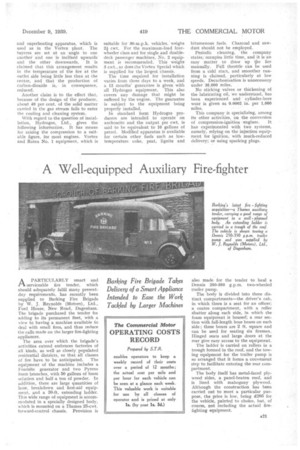New Water-using Gas Producer
Page 22

Page 23

If you've noticed an error in this article please click here to report it so we can fix it.
Superheated Steam and Preheated Air Among Features of the Hydrogas Plant
WITH the announcement of the VV introduction of a new gas producer called the Hydrogas, comes news that Preston Corporation is to employ it on a double-deck bus. The maker of the plant is Hydrogas, Ltd., New Spring Works, Wigan, of which company Mr. K. R. Turner, well known in connection with the Standish Truck Co.. is managing director.
There is a number of interesting features about the Hydrogas producer which will be produced in two forms named respectively the Vortex and the Rotex. Notable among these is that the gas is enriched by the introduction A20 of superheated steam to the fire, and the base of the fire bed is cooled as a result. Also the air is pre-heated before admission.
Of the up-draught type, with a flat fire bed, the Vortex producer has a water jacket around the hopper. From this, water is fed to a spiral pipe, encircling the fire and running down . . wards, in which steam is generated and superheated. Surrounding the furnace is an air jacket through which the air is drawn and pre-heated on its way to the fire.
Provision is made for mixing the air and steam, and for maintaining the proportions of the mixture. Although the producer operates at a high temperature, the steam keeps the base cool, thus discouraging clinker 'formation.
Two tuyeres are employed in the Rotex producer, which is of the crossdraught type. They are small and water cooled, their jackets serving to amplify the action of the steam-raising and superheating apparatus, which is used as in the Vortex plant. The tuyeres are set at an angle to one another and one is inclined upwards and the other downwards. It is claimed that this arrangement results in the temperature of the fire at the outlet side being little less than at the centre, and that the production of carbon-dioxide is,in consequence, reduced.
Another claim is to the effect that, because of the design of the producer, about 40 per cent. of the solid matter carried in the gas stream fails to enter the cooling and cleaning system.
With regard to the question of installation, Hydrogas, Ltd., gives the following information. It has means for raising the compression to a suitable figure, for most engines. Vortex and Rotex No. 1 equipment, which is suitable for 30-m.p.h. vehicles,. weighs cwt, For the maximum-load fourwheeler class and for single and doubledeck passenger machines, No. 2 equipment is recommended. This weighs 3 cwt., as does the Vortex Special which is supplied for the largest chassis.
The time required for installation varies from three days to a week, and a 12 months' guarantee is given with all Hydrogas equipment. This also covers any damage that might be suffered by the engine. The guarantee is subject to the equipment being properly installed.
In standard form Hydrogas producers are intended to operate on anthracite and the output per cwt. is said to be equivalent to 10 gallons of petrol. Modified apparatus is available for certain other fuels such as lowtemperature coke, peat, lignite and
bitumenous fuels. Charcoal and sawdust should not be employed.
Periodic cleaning, the company states; occupies little time, and it is an easy matter to draw up the fire manually. Full throttle can be used from a cold start, and smoother running is claimed, particularly at low speeds. Decarbonization is unnecessary under 35,000 miles.
No sticking valves or thickening of the lubricating oil, we understand, has been experienced and cylinder-bore wear is given as 0.0002 in. per 1,000 miles.
This company is specializing, among its other activities, on the conversion of compression-ignition engines. It has experimented with two systems, namely, relying on the injection equipment for ignition, with much-reduced delivery; or using sparking plugs.




















































